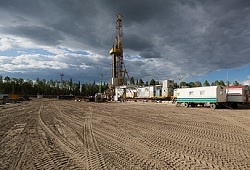- Home page /
- New technologies and equipment /
- SPD Pioneered Radial Drilling
SPD Pioneered Radial Drilling
 |
| Courtesy of salympetroleum.com |
SPD has successfully completed the first radial drilling operation in the history of the Salym project. In one of the wells at West Salym SPD drilled 4 lateral holes 100 meters (328 ft) long. The work was done in full compliance with the highest HSSE standards and took 8 days to prepare the well and 100 hours to drill the laterals.
Radial drilling is one of the technologies SPD is implementing to increase well productivity by reaching small oil pools which were not produced before. Application of such technologies enables SPD to constantly work on drilling and completion technologies improvement and to focus on finding new opportunities for hydrocarbons production.
SPD has already completed radial drilling at 3 wells; another 2 well interventions are to start in due course as part of the radial drilling pilot project. “Our current focus is on monitoring and collecting statistical information about operations and well performance after radial drilling activities in the wells. After collecting and analyzing the data, we will reach a decision on further application of this technology at Salym fields,” said Peter van Welsenes, SPD Well Engineering Manager. This technology could have high impact on the Salym oil fields development in case of application in the vast areas of undeveloped low net-to-gross sands and flank areas.
Radial Drilling is an effective and fast way of increasing the productivity of existing wells, especially in complicated layered pools where conventional horizontal drilling and multiple vertical drilling are not commercially viable. Traditional perforations penetrate only about 0.5 meter (1.64 ft) whereas radial drilling technology can penetrate the formation up to 100 m (328 ft) in channels of 50 mm (1.96 in.) diameter using high pressure fluid. Amongst others, the benefits of radial drilling are simple and easy to operate equipment, fast penetration, low cost and no CAPEX required, low environmental risks.
Source: salympetroleum.com

